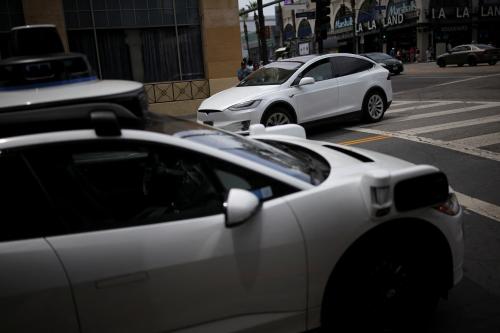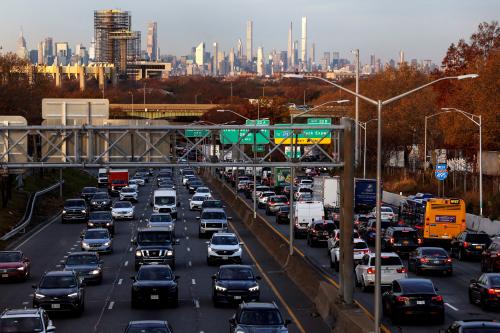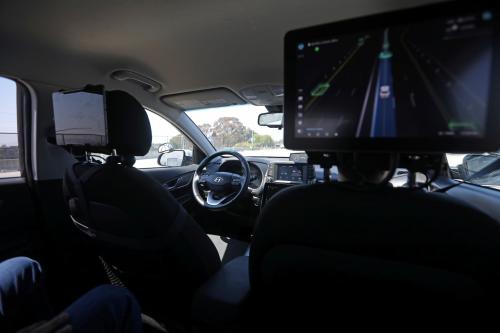Twenty years ago this week, President George H.W. Bush signed the Intermodal Surface Transportation Efficiency Act of 1991 into law. Even casual observers of transportation policy recognize the refreshing-sounding acronym (ISTEA or “Ice Tea”) and the other clunky-sounding TEA bills that followed (TEA-21 and SAFETEA-LU).
ISTEA is rightly considered to be a watershed moment in U.S. transportation policy. It offered a new framework for thinking about transportation by assuring states and metropolitan areas of specific levels of funding and giving them the flexibility needed to design transportation mixes that met their needs. Spurred on by these reforms, a small but increasing number of states and localities began to experiment with a more balanced mix including expanding and preserving highways, addressing the needs of older and newer communities, and deciding between building roads or enlarging public transit systems.
Make no mistake, ISTEA turned transportation policy on its head.
One area of particular importance is often attributed to the keen insights of the late Sen. Daniel Patrick Moynihan, a key architect of ISTEA. Moynihan and other urban thinkers and policymakers have long recognized the need for a metropolitan approach when it comes to addressing transportation.
There are many reasons. Supplier networks and customer relationships are regional rather than local in nature. Labor markets and commuting patterns cross jurisdictional and state lines. Firms make decisions on location and expansion based on regional advantages and amenities. Metropolitan areas are where most Americans live, work, and produce the majority of the nation’s economic output. The services and revenues they generate drive state economies.
ISTEA established a greater voice for metropolitan areas by devolving greater responsibility for planning and implementation to metropolitan planning organizations (MPOs). These regional bodies were originally research organizations charged with advising state departments of transportation. By enhancing the powers and responsibilities of MPOs, ISTEA enabled metropolitan areas to tailor transportation plans to the realities of their distinct markets. MPOs are held accountable through a regular certification process intended to ensure adherence to statutory economic and environmental performance measures, principles of effective citizen engagement, and compliance with other applicable federal laws, such as environmental protection and civil rights.
Twenty years later, the question remains: Did it work?
Despite the federal framework most localities, states, and the federal government have not truly embraced a metropolitan vision for transportation. Decisionmaking is still largely the province of state departments of transportation, and, more often than not, investment choices are made on the basis of consensus building through logrolling where funds are spread around like peanut butter rather than on prioritization. Certainly this is not what ISTEA’s framers had in mind.
The challenge now is that while ISTEA represented one of the rare occurrences where federal legislation was ahead of the nation in its thinking, Congress is no longer singing that tune. So what Washington can do is recognize that a new leadership class of political, business, university and civic leaders is transcending old models by acting decisively to connect transportation to metropolitan economic realities.
In the absence of federal leadership, metropolitan areas around the country are acting on their own to envision, design, and finance the next generation transportation system in America. Places as diverse as Charlotte, Denver, St. Louis, Oklahoma City, Seattle, Phoenix, and Milwaukee—are taxing themselves, dedicating substantial local money, and effectively contributing to the construction of the nation’s critical infrastructure system. The federal government needs to follow and align its resources to help those that help themselves.
Metros like Sacramento, Salt Lake City, Chicago, and Minneapolis-St. Paul are examples of places working to move regional planning away from simply aggregating lists of local projects, and instead specifically connect metropolitan growth with transportation investments. This approach examines land use patterns, density, and urban form to find innovative solutions to challenges like housing, carbon emissions, agricultural preservation, economic development, and job access.
Others like San Francisco are applying rigorous analytical criteria and performance assessments to how they plan to spend taxpayer dollars. The Metropolitan Transportation Commission there ranked their local members’ projects with a combination of qualitative assessment from an advisory board and quantitative modeling of cost-benefit analysis for a select number of projects. The idea is prioritize those projects that score the highest, not just those with the greatest political support.
These kinds of innovations and self-help epitomize a new 21st century approach to strengthening metropolitan economies that Washington should explicitly embrace. Recognition might include: more direct funding to certain MPOs, more flexible “mode neutral funding,” more streamlined planning processes, more direct reporting to federal agencies, and reduced bureaucracy.
Other examples abound and great potential exists to build on the gains of ISTEA in order to strengthen the economic vitality of metropolitan areas and, therefore the nation. The overall vision is not that different from what visionary Congressional leaders laid out two decades ago. The difference is that, unlike 1991, it is clear the innovation today is going to come from the bottom-up and not the top-down.
Happy anniversary, ISTEA. Or something.
The Brookings Institution is committed to quality, independence, and impact.
We are supported by a diverse array of funders. In line with our values and policies, each Brookings publication represents the sole views of its author(s).



Commentary
Transportation Reform of 1991 Remains Relevant
December 19, 2011